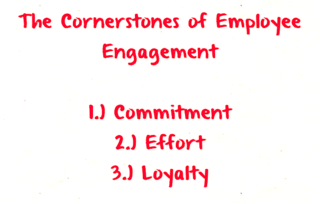Download Free Report: Productivity Secrets for Successful Entrepreneurs
Please share today's post on Twitter, Facebook or any favorite social media site. We appreciate your feedback. Thanks!
Contributing Author: Don Miller
As leaders we are always looking for new ways to stimulate our business.
Looking to gain that competitive advantage we benchmark, invest in new technology, and expand by using loans and lines of credit. We outsource to streamline and go “lean,” hire consultants, attend all kinds of seminars, and we still struggle to manage our rapidly changing business environment.
Think back to a time in your childhood, and recollect a time when Mom was exasperated, frantically looking all over the house for her misplaced car keys or some other item that was extremely important to her and finally, locating the lost item hearing her say something like…"It's always the last place I look!"
Employee engagement is very similar – it’s about looking to that resource that is at the heart of every company and business – it’s often the last place we look – at the voice of the employee.
Companies that seek to actively engage their employees unbridle extra commitment, effort, and loyalty – the three cornerstones of employee engagement.

Employee engagement helps to accelerate productivity, creativity, innovation, customer service, and numerous other key business metrics that are critical in today’s competitive business environment.
Voluminous studies have been conducted world-wide that underscore and articulate a strong, positive, relationship between a work environment of dynamically engaged employees and robust business performance.

Below are seven highlights from a handful of those studies:
-
Highly engaged employees outperform their disengaged and disconnected counterparts by 20 – 28%. (The Conference Board)
-
Engaged employees generate upwards for 40% more revenue than the disengaged. (Hay Group)
-
84% of highly engaged employees believe they can have a significant impact on the quality of their company’s product or services as compared with 31% of the disengaged. (Towers Perrin)
-
Engaged employees take an average of nearly 60% fewer sick days per year than employees who war disengaged. (Gallup)
-
Engaged employees are 87% less likely to leave the organization than the disengaged. (Corporate Leadership Council)
Now consider these particular findings:
-
Almost 80% of an organizations market value comes from imperceptible or intangible assets like intellectual property, brand, and quality of workforce. (The Brookings Institute)
-
75% of today’s business leaders have no employee engagement plan or strategy – even though 90% of them indicate that engagement positively impacts their business success. (Accor Services)

So why is it that so many business leaders make employee engagement such a low priority?
In most cases it’s really quite simple, they either don’t know how or they just don’t want to.
If you have ever thought of establishing an employee engagement plan into your overall business strategy and do a thorough analysis of your organization, you’re quite likely to discover where your business could be impacted by reassigning the value you place on your employees and the voice they provide to your business.
When organizational and personal values are brought to life in front of the employee, employee engagement often follows.
Walking the walk, and talking the talk builds trust and empowers leaders whom are respected, admired, and followed.

Here are nine strategies to maximizing your team’s effort, commitment, and loyalty:
-
Let your values be your guide.
With only rare exceptions, all employees desire to be part of something special and they want to work for good people whom they respect. Being values driven with help you to meet both of these desires
-
Communicate you way to commitment.
Most employees want to know where the organization is headed and why it wants or needs to get there. The more employees understand those things the greater the likelihood they will be engaging in and committed to their jobs. Helping them understand those things is through communication.
-
Focus on relationships.
The more positive your relationships with your team members and the people you depend on, the more trust you will earn, and the more engaged your employees will become.
-
Demonstrate that you trust them.
Relationships without trust will often foster feelings of hostility and even disloyalty. Show your employees that you trust them. This can even be accomplished with a simple one-off event, such as letting the secretary use your credit card to book a flight for you. Or when appropriate, make employees authorized users on the company credit card. Because of its importance, money is one of the most effective tools for demonstrating trust.
-
Concentrate on change.
You can have a significant impact on how your team members deal with change. Change is inevitable and you can go a long way to helping your employees understand, accept, and work though change more effectively.
-
Create an empowering environment.
Leaders who want to cultivate and sustain high levels of employee engagement need their employees’ ideas and commitment. Creating a positive work environment can go a long way to accomplishing this goal.
-
Recognize what you want more of.
Far too many leaders fail to recognize their employees In a visible, meaningful way.
Effective recognition drives employee engagement. Modestly put, whatever you recognize you will generally get more of.
-
Help everyone learn and grow.
When you help people develop, it underscores and displays that you truly care about their success and it’s a good sign that you are engaged in their well-being and have their best interest at heart. Helping employees learn and grow prepares them, and your organization to meet future challenges.
These are nine key strategies to employee engagement for maximizing your employees’ commitment, effort, dependability and loyalty to you as a leader and to the overall success of your business, but you have to make the first step by making the decision to place employee engagement as an overall part of your strategic plan.
About the Contributing Author:

He has the heart of entrepreneur and regularly contributes to small business and entrepreneur websites. Follow Credit Card Forum on Twitter.

